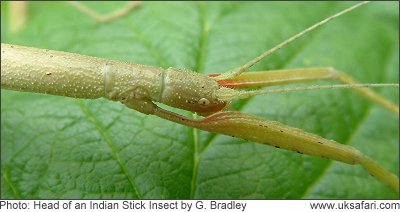
|

|
|
 Sent
to you Sent
to you
by e-mail
|
|
Simply
enter your details and hit the send button
more
info |
|


Click Here

Links
Advertise
Terms of Use
Contributors
About Us
Contact Us
|
 |
Go back
 | Bookmark
| Bookmark
 | Print Page
| Print Page  | E-Mail Us
| E-Mail Us 
 Stick Insects
Stick Insects
Latin name: Carausius morosus
Size: Length approx. 80mm.
Distribution: Found mainly in the south of England and the Channel Islands.
Months seen: May to October.
Habitat: Hedgerows, gardens and roadsides.
Food: Bramble or privet.
Special features: Indian Stick Insects as the name suggests originate
from Asia. They are one of four species of stick insects which have been
inadvertently released into the UK countryside from private collections. The
other three species are the Prickly Stick-insect (Acanthoxyla geisovii), the Unarmed Stick-insect
(Acanthoxyla inermis), and the Smooth Stick-insect (Clitarchus hookeri).
Indian Stick insects are normally killed off by frosts, but mild
winters in recent years are allowing their numbers to increase.
Their bodies are coloured either olive green, yellow-green or brown. When mature their undersides have a pink flush and the insides of their front legs can be a pale red
colour. The antennae are as long as the legs.
 |
Stick insects are mainly active at night, and live for about one year. During their life they will go through six skin
moults.
Indian stick insects are parthenogenetic, which means they can reproduce without mating. Females lay
one or two eggs each day, and can produce hundreds during their short lifespan.
The eggs hatch within eight to fifteen weeks depending on the air temperature.

UK Safari Creepy-crawlies Section
|
 |

|